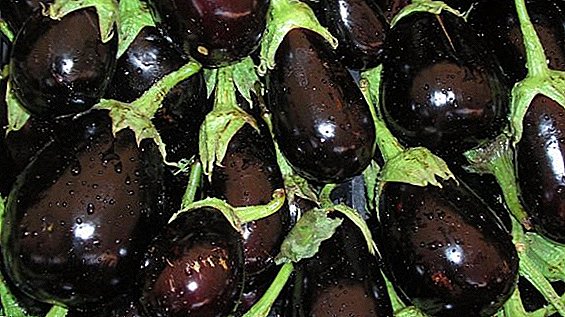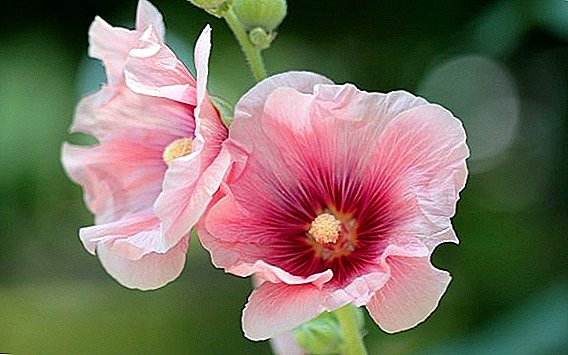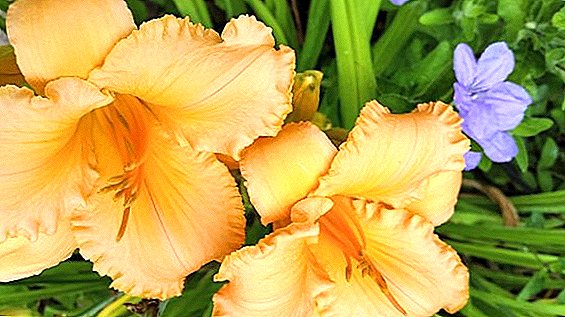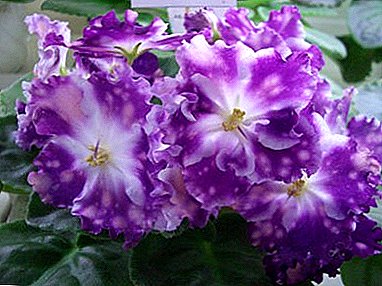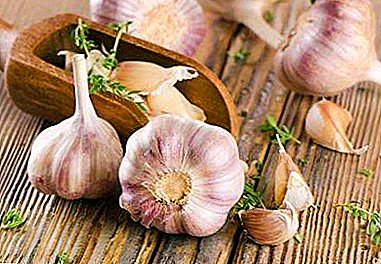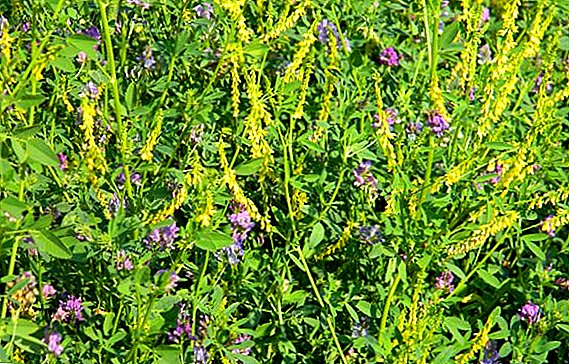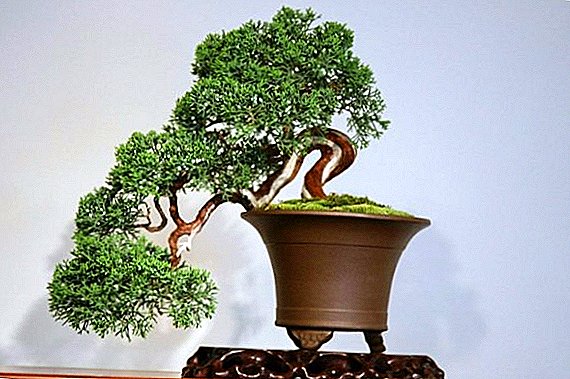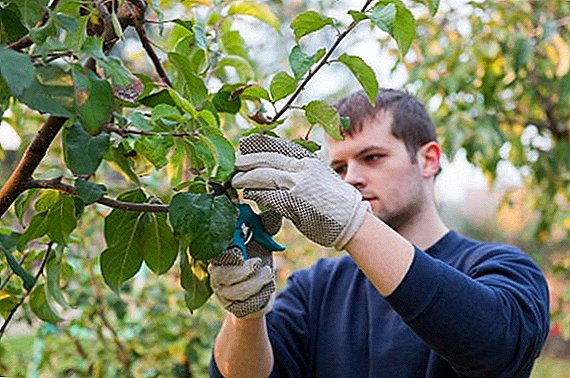 Grafting is an ideal way to preserve the valuable varietal qualities of trees and, if it is not possible to replace old plantations, then using this procedure, a quick and inexpensive garden renovation takes place.
Grafting is an ideal way to preserve the valuable varietal qualities of trees and, if it is not possible to replace old plantations, then using this procedure, a quick and inexpensive garden renovation takes place.
The essence of the procedure
The graft is based on the ability of trees to protect their integrity, possibly due to the cambium - the active substance that is under the bark.
In this procedure, using a graft (what we plan to plant) and a stock (what we graft onto) specially made cuts are superimposed on each other so that the cambium layers are joined. Then they are pressed tightly against each other and give time for accretion.
Grafting fruit trees allows you to:
- preserve the value of the variety that is lost during pollination;
- about half the time to start fruiting;
- if you choose the right stock, you can grow a dwarf specimen, then the fruit will ripen faster;
- You can grow varieties that are not adapted to your climatic conditions, but due to the rootstock with well-developed roots, the tree can become resistant to drought and not freeze in the winter;
- it is easy to grow several varieties on one stock, that is, it will be possible to collect different fruits from one tree;
- try out a new variety, and if it meets all the requirements, then allocate a place for planting a separate specimen;
- the perfect solution is to plant a pollinator variety;
- keep the shtamb injured by beasts or sunburn;
- increase the yield and endurance of trees;
- completely renovate the garden without large financial costs.
Did you know? The summer method of grafting was invented and patented in Lithuania in the early 80s. The operation was carried out on a pear, and the result is a survival rate of a stock of 97%.

Procurement of cuttings and timing
The success of any vaccination of trees in the summer depends on the right scion and the timing of the procedure. This is the period of maximum sap flow (the second half of July - August), when the shoots grow, and are not at rest.
Cuttings are cut from healthy with good fruiting of the tree from the outside of the crown with maximum sun illumination. Shoots should be annuals with smooth bark and healthy foliage. Their length should be up to 40 cm, the diameter of the slice is 6 cm. The main condition is that the graft should have two formed buds.
In the process of grafting experienced gardeners often use a grafting pruner.Cuttings are best cut on the day of vaccination in the early morning (up to a maximum of 10 hours) and use them for 3 hours. If they were not managed during this time, remove the cuttings in a cool place, wrapping them in a damp cloth.

Vaccination methods
There are many ways of grafting, and in order to know how and when to plant fruit trees correctly, you need to take into account the age of the rootstock, the thickness of the branches, the timing of maximum sap flow, and also possess the necessary skills.
Each method has its own characteristics that you need to know and take into account.
Important! Grafting is stressful for a tree, which becomes vulnerable to all kinds of bacteria. Therefore, you need to be sure that there are no plants infected with any disease nearby, otherwise the tree to be planted may simply die.
Budding
Budding is a reliable method for reproduction of valuable varieties, in which it is possible to obtain the greatest number of seedlings with the minimum amount of graft material, since one cutting produces several buds.
The presented method is popular, and it is used by many nurseries. It involves implanting a stock in a stock, taken from an annual branch of a healthy and varietal tree, which must have whole leaves and bark without damage.
The length of the cutting used should be 40 cm. Two methods of budding are known: so, if the bark moves away easily, then use a T-shaped incision, and if it is bad, use a flattener.
Types of budding:
- Vaccination vpriklad and T-shaped incision. Cut the kidney from the prepared stalk and apply it to the slice or insert it into the incision of the bark. The eye must be taken from the middle of the cutting, and should not exceed 2.5 cm. If it is smaller, then there will not be enough nutrients for the kidney, and if there is more, it will be difficult to perform this operation.
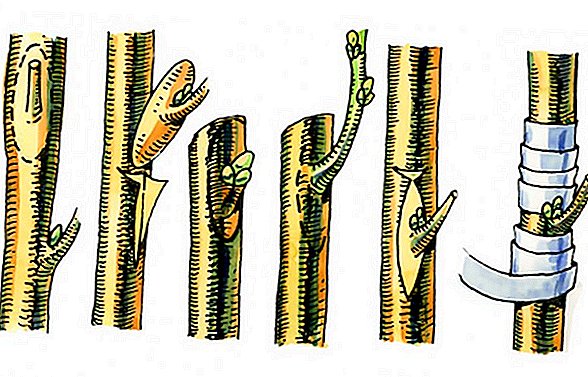
- Budding over the bark. All leaves are removed on the handle, and the stalks remain, for which it is easier to hold it during the procedure. The kidney is cut out with bark and inserted into a T-shaped incision. This place is tied with a film. The kidney remains open, and to reduce the evaporation of moisture, the edges of the incision are smeared with garden putty.
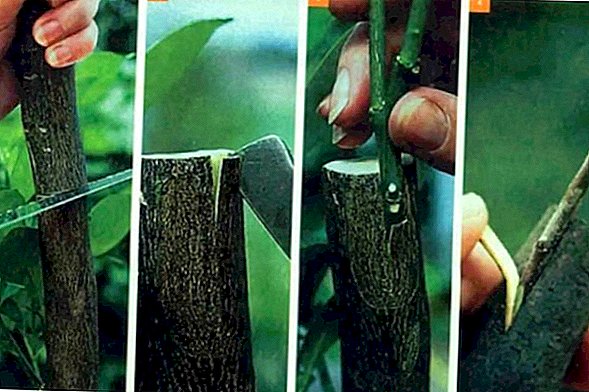
- Vaccination "pipe". The bark is cut off by a ring, and the kidney is left without wood. This method is very laborious and requires great care when cutting the bark. Note that the stalk and stock should be the same diameter. The main advantage of the method is in a large area of contact between the rootstock and the graft, and if the sections are well adjusted, then there will be no trace of the operation on the seedling.
Important! Professionals with experience recommend that on hot days, the site of vaccinations should be protected from sunlight by wrapping them with a plastic bag filled with moss to create moisture. It is better to perform actions from the north side of the stock.
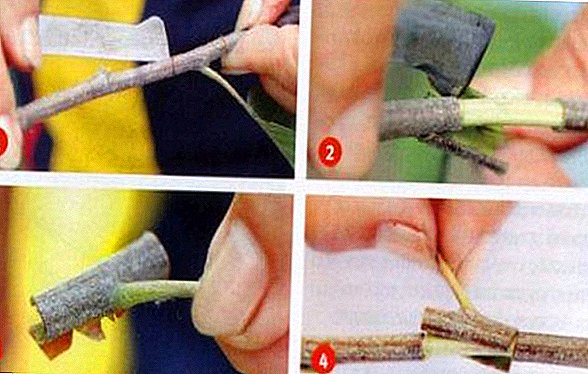
By the bridge
To restore the bark, which was damaged by the spring sun or eaten by animals, it is necessary to perform a summer graft bridging. It is suitable for both apple and other trees.
Learn more about such popular varieties of apple trees as "Lobo", "Semerenko", "Sinap Orlovsky", "Melba", "White filling", "Antey", "Silver Hoof".
If the bark is partially damaged, then one bridge is used, if it is damaged around the trunk or branch, then such a number of bridges (cuttings) are installed so that the distance between them is no more than 3 cm.
The cuttings grow together, connecting the separated parts of the bark, and provide nutrition to the damaged areas. The performed grafting leads to the expansion of the trunk, because the lower and upper parts of the cutting go under the bark of the tree.  It is important that it is slightly springy after insertion into the cuts, so its length should be a couple of centimeters larger than the required size.
It is important that it is slightly springy after insertion into the cuts, so its length should be a couple of centimeters larger than the required size.
The vaccination itself is performed as follows:
- The edges of the wound expand to healthy tissue.
- Cleats behind the bark should be made below and above the injury site.
- At the ends of the blanks make cuts that should be in the same plane.
- Cut the cuttings at one end into the gaps so that the cuts are directed toward the trunk wood.
- We arch them and insert another cut under the bark.
- The site of vaccination is well treated with garden pitch, wrapped with tape or wide string. To preserve moisture and prevent the sprouting of the "bridges", we cover the top with plastic wrap.
Graft bridges from cuttings mainly quickly grow into the wood of the tree, saving it from death, since they become conductors of nutrients and moisture.
We advise you to read about the proper grafting of pears, apples and grapes.
In split
When figuring out how to plant an apple tree or any fruit tree in the summer in a split, it should be said about the need to make cuts, which will facilitate the easier splitting of the rootstock branches into two parts. You need to know two rules:
- for a young tree saw cut is recommended to be done at a distance of 40 cm from the trunk;
- for an old tree, whose branches are thick, the cut can be performed at a distance of 1 m from the trunk, but the thickness of the branch should be 5 cm.
If the branch is skeletal, it is possible and even necessary to perform several cuts, leaving a distance between them so that the future branch has the correct shape.
On a sapling, it is necessary to plant several cuttings on different branches, but there should be a sufficient distance between them. The sequence of operations when performing the procedure in the split:
- In place of the saw cut install a sharp and durable knife.
- Hammer hit on the end of the blade.
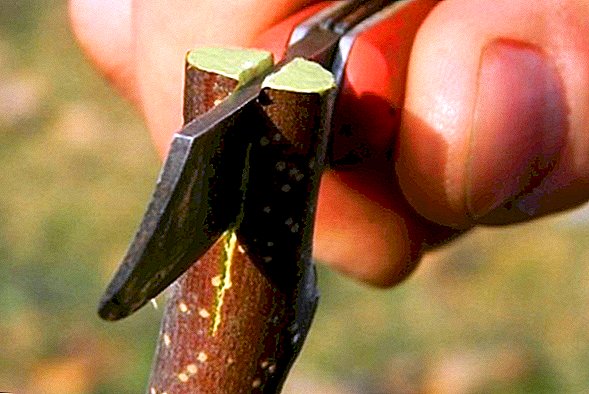
- We obtain splitting, we plant the split parts to the sides and quickly insert the cutting prepared in advance.
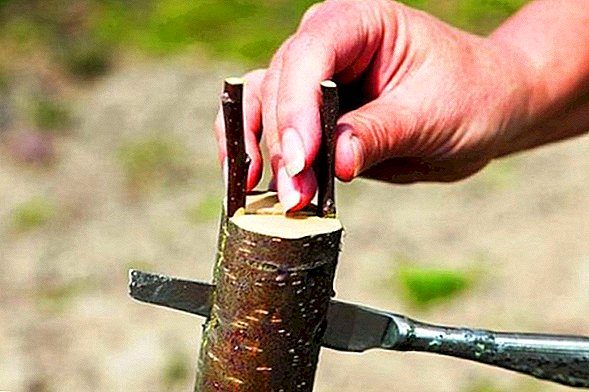
- We take out the knife, break it up with clay and process the graft immediately with a garden pitch. For fixing the desired position of the scion, we fix it with tape or wide string.
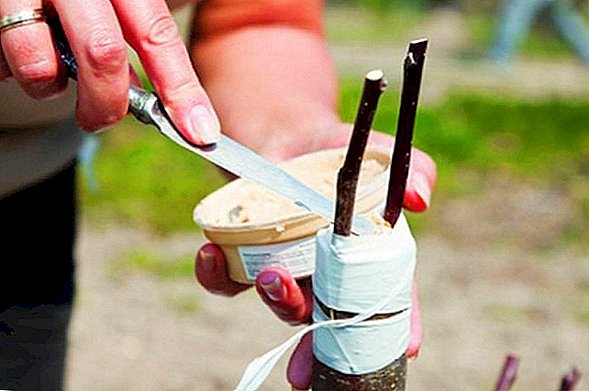
Important! For a good fixation of the cutting in the split in its upper cut part, it is necessary to cut straight sections - hangers, which will be fixatives. With this graft, it is necessary that the bark of the cutting and hemp necessarily coincide.
In the cut
Before the procedure is carried out, it is necessary to prepare a tree that implies rejuvenation. Note that the thickness of the cuttings should be no more than 10 cm.
Another important point: an escape that should provide food should remain below the site of the future cut. Grafting of apple trees by cuttings can be done in the summer, and for this purpose 2 methods are used.
Corner method:
- Choose a branch 2 cm thick. The bark should be fine.
- On the stump with a knife we make two notches, which should be parallel to each other and have a depth of at least 6 mm. In this case, put the knife at a distance of several centimeters from the edge, tilting it at an angle of 30 °.
- The stalk is placed in the cut so that it fits snugly and does not fall out. After this we fill this place with prepared garden pitch.
- The bonding place must be rewound with electrical tape and protected against the ingress of bacteria with plastic wrap.
 Side way:
Side way:- Using a knife at a distance of 20 cm from the base, we make oblique incisions, and one should be 1 cm longer than the other.
- We fix the stalk in the slot and fill it with garden pitch.
- Inoculate the place of vaccination with tape or wide twine and cover it with polyethylene in the same way. You can use a soft garden putty.
 The stalk must be inserted so that the oblique cut is turned to the wood of the stock and the ledge rests on the end of the hemp. Use a few cuttings for guarantee in one notch, since during growth from the wind, grafts may break off.
The stalk must be inserted so that the oblique cut is turned to the wood of the stock and the ledge rests on the end of the hemp. Use a few cuttings for guarantee in one notch, since during growth from the wind, grafts may break off.For further growth leave one powerful accustomed process, which later will become a branch.
Did you know? For dwarf trees, use black chokeberry as a stock for an apple tree and quince or irgu for a pear tree. To get a small peach tree, almonds are better suited.
Benefits of Summer Vaccination
Summer vaccination of young and adult fruit trees gives many advantages:
- decreases the number of harvested cuttings and their shelf life;
- the process of cultivating a plant is reduced by a year;
- spring may not be a good stock;
- if the spring vaccination failed, then there is an opportunity to repeat it in the summer;
- the stalk, cut with a piece of last year's bark, survives 100%;
- fusion occurs well, as the callus grows rapidly, making the joint strong and invisible;
- by the fall it will be clear whether the procedure is successful or not.
 By resorting to summer grafts of fruit trees, you absolutely get the desired result, which allows you to save the desired variety and rejuvenate the garden.
By resorting to summer grafts of fruit trees, you absolutely get the desired result, which allows you to save the desired variety and rejuvenate the garden.







